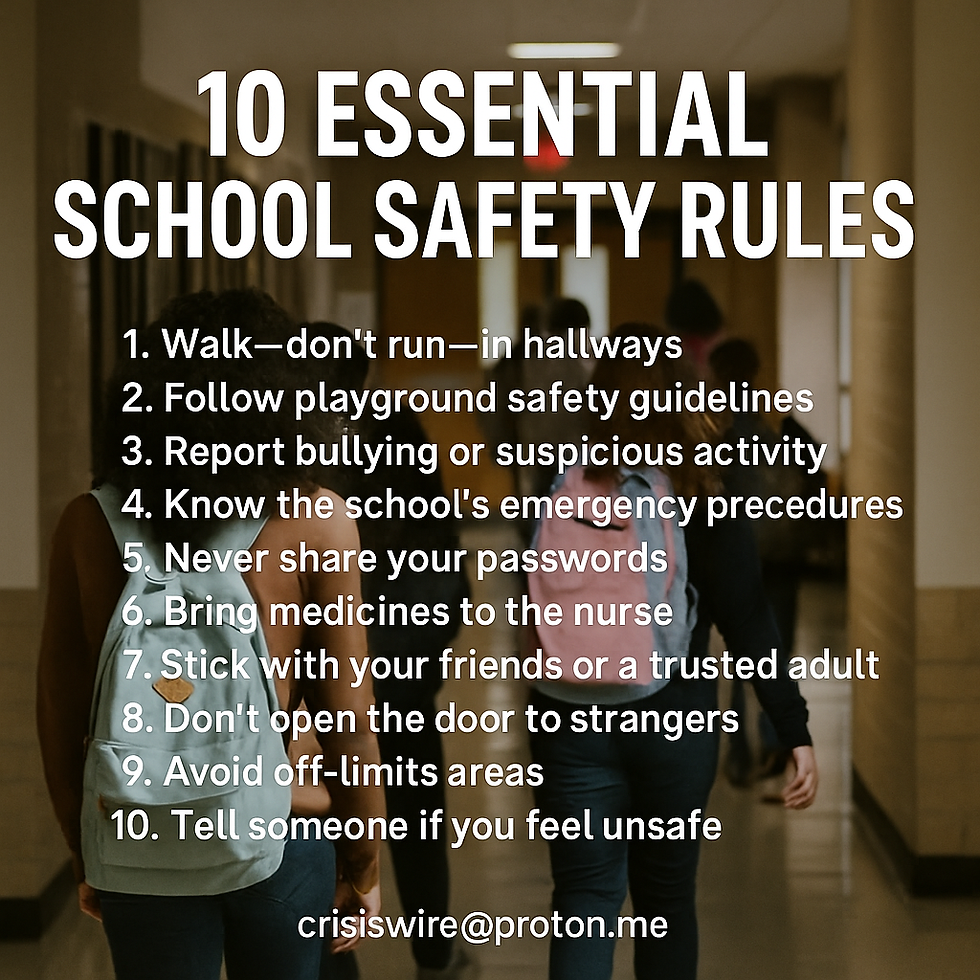What Are the 10 Safety Rules for School?
- CrisisWire

- Sep 27
- 2 min read
School should be the safest place in a child’s day. Yet, rising incidents of bullying, violence, intruders, and emergencies reveal one truth: safety doesn’t happen by accident. It happens by rules, reinforced with accountability.
Below are the 10 safety rules every school must adopt — not as suggestions, but as non-negotiable standards for protecting lives.
1. Secure All Entry and Exit Points
Every unlocked door is a risk. Limit entry to monitored checkpoints, enforce visitor sign-ins, and prevent propped-open doors.🔗 Learn more in Locked Down: The Access Control Blueprint for Safer Schools, Colleges, and Corporate America.
2. Enforce Strict Visitor Management
Require government-issued ID, issue temporary badges, and ensure visitors are escorted at all times. No exceptions.
3. Conduct Regular Threat Assessments
Train staff to recognize warning signs of violence and establish a Threat Assessment Team (TAT).📘 See The Threat Assessment Handbook for checklists and scoring rubrics.
4. Teach Students How to Report Concerns
Anonymous reporting systems and student awareness campaigns ensure issues are flagged early. Encourage a “see something, say something” culture.

5. Practice Emergency Drills Frequently
Lockdown, evacuation, fire, and shelter-in-place drills should be practiced often — and evaluated for effectiveness.
6. Prioritize Cyber & Social Media Safety
Online threats spill into the classroom. Monitor platforms for threats and teach students safe digital behavior.📘 Related: Campus Under Siege: Why Universities Are Soft Targets — and How to Fix Them.
7. Supervise Common Areas
Hallways, cafeterias, gyms, and bus stops are hotspots for bullying and altercations. Assign staff and install cameras for oversight.
8. Strengthen Communication Systems
Ensure schools can issue a mass notification in under 3 minutes. Delays cost lives.🔗 Practical solutions inside The Prepared Leader.
9. Build Partnerships with Law Enforcement
Maintain direct relationships with local police, fire, and emergency management. Pre-plan joint drills and incident responses.
10. Train Teachers and Staff as First Responders
Faculty are the first on scene. Train them in situational awareness, de-escalation, CPR, AED use, and bleeding control.
Conclusion
The reality is simple: safety requires rules, and rules require enforcement. Schools that fail to implement these 10 rules risk becoming the next headline.
📧 For schools, universities, or businesses seeking customized threat assessments and security planning, contact us at crisiswire@proton.me.





Comments